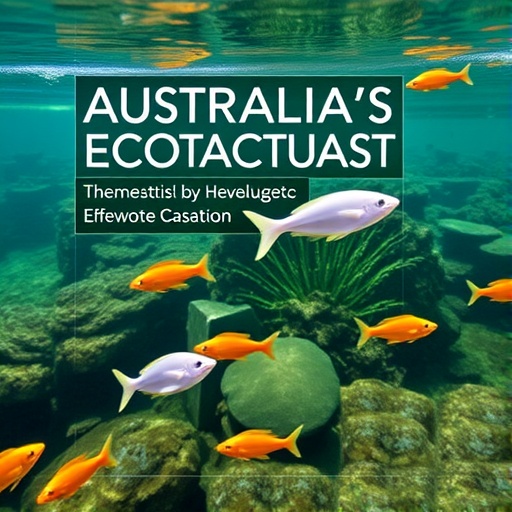Pharmaceutical contamination in aquatic systems is emerging as a critical environmental issue, particularly in regions like Australia, where freshwater ecosystems are under significant pressure from both human activity and climate variations. Recent findings by researchers Kneebone, Hensher, and Paull shed light on the widespread presence of pharmaceuticals in Australian waters, raising alarms about their potential impact on aquatic life and human health. This comprehensive review emphasizes the need for a robust understanding of the ecological risks posed by these contaminants, which have increasingly been detected in rivers and streams across the continent.
Pharmaceuticals enter aquatic environments through various pathways, including sewage discharge, agricultural runoff, and improper disposal by consumers. Wastewater treatment facilities, while designed to purify water, often fall short in eliminating certain pharmaceutical compounds. As a result, these substances accumulate in natural water bodies, leading to toxic consequences for aquatic organisms. Field studies have shown that even trace amounts of pharmaceuticals can disrupt endocrine functions in fish and other wildlife, leading to reproductive problems and population declines.
The ecological ramifications of pharmaceutical pollution are not confined to the immediate vicinity of their introduction. Many aquatic species, including fish and amphibians, are pivotal to the food web, and the effects of toxicants can ripple through ecosystems. The findings from the review indicate that key species such as native fish and other aquatic organisms show signs of bioaccumulation of these chemicals, subsequently endangering predators and, ultimately, human beings who rely on these ecosystems for food and recreation.
Importantly, the detection of multiple pharmaceutical classes in Australian aquatic environments underscores the complexity of the issue. Antibiotics, analgesics, and hormone replacement therapies are among the most frequently identified compounds, each bringing its own array of ecological risks. For instance, the use of antibiotics in agriculture, followed by runoff into nearby waterways, has been implicated in the rising incidence of antibiotic-resistant bacteria, posing additional challenges to public health.
Moreover, researchers have expressed concern regarding the potential for pharmaceuticals to affect aquatic biodiversity. Altered behaviors in fish, such as changes in mating rituals and social structures, have been documented as a result of exposure to pharmaceutical pollutants. Such behavioral changes can ultimately alter community structures within ecosystems and affect their resilience to environmental changes.
One of the significant challenges highlighted in the review is the lack of regulatory frameworks aimed explicitly at managing pharmaceutical contaminants in water bodies. While there are existing guidelines for water quality, they often overlook the specific threat posed by pharmaceuticals. The researchers advocate for an integrated approach that includes stricter regulations for wastewater treatment processes, focused research on emerging contaminants, and public awareness campaigns to mitigate improper disposal.
The research also emphasizes the urgency of conducting long-term ecotoxicological studies to elucidate the chronic effects of pharmaceutical exposure. Most studies to date have focused on short-term impacts, yet living systems are often affected cumulatively and over extended periods. Understanding the long-term consequences is essential to forge effective conservation strategies and policy measures.
In aligning policies with environmental health, there is a growing call for collaboration between governments, industries, and communities. Innovations in wastewater treatment technology, pharmaceuticals’ design with their lifecycle assessed, and improved waste management practices can aid in staggering the effectiveness of pollution mitigation. Public education campaigns about the environmental implications of pharmaceutical disposal could also lead to more responsible consumer behavior.
To address the viewpoint of those who argue that pharmaceutical contamination is an unavoidable byproduct of modern civilization, it is essential to represent the occurrence of pollution as a solvable issue rather than an existential crisis. By proactively tackling the sources of contamination before they reach aquatic environments, stakeholders can significantly mitigate the ecological risks involved.
The review’s findings resonate with concerns being raised globally about environmental pollution, making it a timely contribution to the discourse. As governments and international bodies look to enact stronger environmental protection measures, research like this will guide decision-making processes aimed at promoting sustainability and biodiversity conservation.
In conclusion, the study on pharmaceuticals in Australian aquatic environments highlights the necessity of recognizing and addressing pharmaceutical pollution as a burgeoning ecological crisis. The researchers’ findings call for concerted efforts to understand better the impacts, establish robust regulatory frameworks, and encourage sustainable practices that safeguard aquatic ecosystems for future generations. The call to action is clear: we must prioritize the health of our waters for their diverse inhabitants and our own well-being.
Effective strategies toward mitigating this issue will require a multidisciplinary approach, drawing insights from environmental science, public health, and community engagement. Policing pollution through legislations, enforcing responsible use and disposal of pharmaceuticals, and investing in greener technologies will be paramount as societies navigate the intricate relationship between health care, industry, and ecological stewardship.
Ultimately, the road ahead is fraught with challenges but also opportunities for innovation and collaboration across sectors. By prioritizing chemical safety and actively seeking solutions to pharmaceutical contaminants in our aquatic ecosystems, we can lead the way in protecting biodiversity, enhancing ecological resilience, and fostering healthier communities.
Subject of Research: Ecotoxicological assessment of pharmaceuticals in Australian aquatic environments
Article Title: Occurrence and ecotoxicological assessment of pharmaceuticals in Australian aquatic environments: a review
Article References: Kneebone, J., Hensher, M. & Paull, B. Occurrence and ecotoxicological assessment of pharmaceuticals in Australian aquatic environments: a review.
Environ Sci Pollut Res (2025). https://doi.org/10.1007/s11356-025-37032-9
Image Credits: AI Generated
DOI: 10.1007/s11356-025-37032-9
Keywords: Pharmaceuticals, Aquatic environments, Ecotoxicology, Environmental health, Water pollution, Australia




